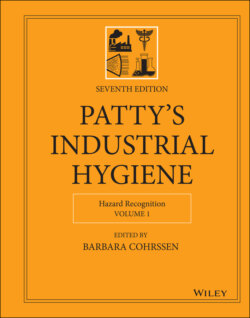Читать книгу Patty's Industrial Hygiene, Hazard Recognition - Группа авторов - Страница 100
Bibliography
Оглавление1 1 Lyon, B.K., Walline, D., and Popov, G. (2019). Moving risk assessment upstream to the design phase. Professional Safety 11: 24.
2 2 Bureau of Labor Statistics (2019). Census of fatal occupational injuries (CFOI) – current and revised data. https://www.bls.gov/iif/oshcfoi1.htm (accessed on September 1 2020).
3 3 Safe Work Australia (2014). Work‐related fatalities associated with unsafe design of machinery, plant and powered tools, 2006–2011. https://www.safeworkaustralia.gov.au/system/files/documents/1702/work‐related‐fatalities‐unsafe‐design.pdf (accessed on September 1 2020).
4 4 Lyon, B.K., Popov, G., and Biddle, E. (2016). Prevention through design for construction hazards. Professional Safety 9: 27.
5 5 Behm, M. (2005). Linking construction fatalities to the design for construction safety concept. Safety Sci 43 (8): 589–611. doi: 10.1016/j.ssci.2005.04.002.
6 6 Taubitz, M.A. (2018). PtD before risk assessment. Professional Safety 11: 27. http://aeasseincludes.assp.org/professionalsafety/pastissues/063/11/F1Taubitz_1118.pdf?_ga=2.70444624.1127355930.1570501873‐720585948.1558016962 (accessed on September 1 2020).
7 7 Schulte, P., Rinehart, R., Okun, A. et al. (2008). National prevention through design (PtD) initiative. J Safety Res 39: 115–121. www.cdc.gov/niosh/topics/ptd/pdfs/Schulte.pdf
8 8 Lyon, B.K. and Popov, G. (2018). Risk Management Tools For Safety Professionals. Park Ridge, IL: American Society of Safety Professionals.
9 9 Lyon, B.K. and Popov, G. (2019). Risk treatment strategies: harmonizing the hierarchy of controls & inherently safer design concepts. Professional Safety 5: 41.
10 10 Stephans, R.A. (2004). System Safety for the 21st Century: The Updated and Revised Edition of System Safety 2000. Hoboken, NJ: John Wiley & Sons, Inc.
11 11 ANSI/ASSP (2016). Prevention Through Design: Guidelines for Addressing Occupational Hazards and Risks in Design and Redesign Processes [ANSI/ASSP Z590.3‐2011 (R2016)]. Park Ridge, IL: ASSP.
12 12 Popov, G., Lyon, B.K., and Hollcroft, B. (2016). Risk Assessment: A Practical Guide to Assessing Operational Risks. Hoboken, NJ: Wiley.
13 13 ATSDR (2020). Medical management guidelines for sulfur dioxide (SO2). https://www.atsdr.cdc.gov/MMG/MMG.asp?id=249&tid=46#:∼:text=Routes%20of%20Exposure&text=Inhaled%20sulfur%20dioxide%20readily%20reacts,than%200.1%20ppm%20when%20exercising (accessed 1 September 2020).
14 14 Manuele, F.A. (2014). Advanced Safety Management: Focusing on Z10 and Serious Injury Prevention, 2e. Hoboken, NJ: Wiley.
15 15 NLM PubChem (2004). Bethesda (MD): National Library of Medicine (US), National Center for Biotechnology Information. PubChem Compound Summary for CID 3086, Dimethyl dicarbonate. https://pubchem.ncbi.nlm.nih.gov/compound/Dimethyl‐dicarbonate (accessed on September 2 2020).
16 16 NIOSH (2015). NIOSH workplace design solutions: supporting prevention through design (PtD) using business value concepts. In: Centers for Disease Control and Prevention (ed. E. Biddle and S. Afanuh). Cincinnati, OH: U.S. Department of Health and Human Services, National Institute for Occupational Safety and Health. DHHS (NIOSH) Publication No. 2015‐198.
17 17 AIHA (2009). Strategy to Demonstrate the Value of Industrial Hygiene. Falls Church, VA: American Industrial Hygiene Association.
